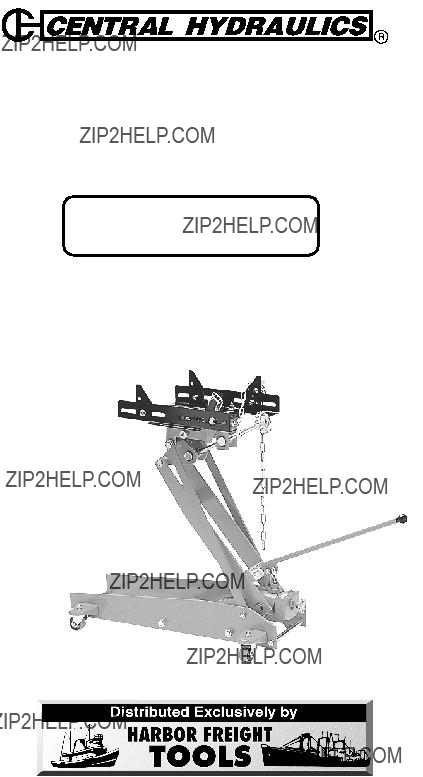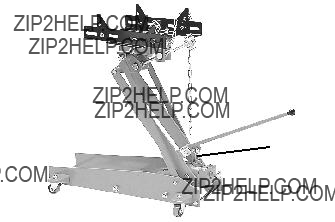TRANSMISSION JACK
ONE TON
 37481
37481
ASSEMBLY and OPERATING
INSTRUCTIONS
??
3491 Mission Oaks Blvd., Camarillo, CA 93011
Copyright ?? 1997 by Harbor Freight Tools ??. All rights reserved. No portion of this manual or any artwork contained herein may be reproduced in any shape or form without the express written consent of Harbor Freight Tools.
For technical questions and replacement parts, please call 1-800-444-3353
Save This Manual
You will need the manual for the safety warnings and precautions, assembly instructions, operating and maintenance procedures, parts list and diagram. Keep your invoice with this manual. Write the invoice number on the inside of the front cover. Keep the manual and invoice in a safe and dry place for future reference.
Safety Warnings and Precautions
WARNING: When using tool, basic safety precautions should always be followed to reduce the risk of personal injury and damage to equipment.
Read all instructions before using this tool!
1.Do not use jack until properly trained. The transmission jack is intended for use by properly trained and experienced personnel only. If you are not familiar with the proper and safe operation of a transmission jack, do not use until trained.
2.Keep work area clean. Cluttered areas invite injuries.
3.Observe work area conditions. Do not use machines or power tools in damp or wet locations. Don???t expose to rain. Keep work area well lighted. Do not use electrically powered tools in the presence of flammable gases or liquids.
4.Secure vehicle. The vehicle must be properly supported and blocked before starting repairs.
5.Do not overload. Use the proper size and capacity transmission jack to handle the anticipated load or damage may occur to the jack and create a safety hazard.
6.Avoid moving parts on the jack. Keep fingers, hands, and arms away from moving parts of the jack at all times.
7.Secure load. Secure the load with a safety chain before lowering or moving.
8.Use jack on hard surfaces only. The jack is designed for use only on hard, level surfaces capable of sustaining the load. Using the jack on a soft surface can result in jack instability and possible loss of load.
9.Keep children away. Children must never be allowed in the work area. Do not let them handle machines, tools, or extension cords.
10.Store idle equipment. When not in use, tools must be stored in a dry location to inhibit rust. Always lock up tools and keep out of reach of children.
11.Do not force tool. It will do the job better and more safely at the rate for which it was intended. Do not use inappropriate attachments in an attempt to exceed the tool capacity.
12.Use the right tool for the job. The use of this jack is limited to the removal, installation, and transportation (in the lowered position), of transmissions and differentials.
13.Dress properly. Do not wear loose clothing or jewelry as they can be caught in moving parts. Protective, electrically nonconductive clothes and nonskid footwear are recommended when working. Wear restrictive hair covering to contain long hair.
14.Use eye and ear protection. Always wear ANSI approved impact safety goggles.
Wear a full face shield if you are producing metal filings or wood chips. Wear an ANSI approved dust mask or respirator when working around metal, wood, and chemical dusts and mists.
15.Do not overreach. Keep proper footing and balance at all times. Do not reach over or across running machines.
16.Maintain tools with care. Keep tools sharp and clean for better and safer performance. Follow instructions for lubricating and changing accessories. Inspect tool cords periodically and, if damaged, have them repaired by an authorized technician.
The handles must be kept clean, dry, and free from oil and grease at all times.
17.Remove adjusting keys and wrenches. Check that keys and adjusting wrenches are removed from the tool or machine work surface before plugging it in.
18.Stay alert. Watch what you are doing, use common sense. Do not operate any tool when you are tired.
19.Check for damaged parts. Before using any tool, any part that appears damaged should be carefully checked to determine that it will operate properly and perform its intended function. Check for alignment and binding of moving parts; any broken parts or mounting fixtures; and any other condition that may affect proper operation. Any part that is damaged should be properly repaired or replaced by a qualified technician. Do not use the tool if any switch does not turn On and Off properly.
20.Replacement parts and accessories. When servicing, use only identical replacement parts. Use of any other parts will void the warranty. Only use accessories intended for use with this tool. Approved accessories are available from Harbor Freight Tools.
21.Do not operate tool if under the influence of alcohol or drugs. Read warning labels on prescriptions to determine if your judgment or reflexes are impaired while taking drugs. If there is any doubt, do not operate the tool.
22.Comply with safety warnings. Failure to comply with all of these warnings may cause loss of load, damage or failure of the jack, or personal injury and property damage.
Unpacking
When unpacking, check to make sure the following parts are included. If any parts are missing or broken, please call Harbor Freight Tools at the number on the cover of this manual. If any part of the machine is missing or broken, please call Harbor Freight Tools at the number on the front cover as soon as possible.
WARNING:
ALWAYS EVALUATE YOUR TASK BEFORE USING THIS JACK. This jack is designed to support a transmission or a differential as individual components.
Assemblies such as a differential with axle, or a transmission with bell housing, can be bulky and difficult to balance on the jack???s platform or cradle.
LIFTING OR SUPPORTING SUCH ASSEMBLIES, EVEN WITHIN THE WEIGHT LIMIT,
CAN CREATE AN OFF-BALANCE SITUATION, CAUSING THE JACK TO TIP OVER
AND LEAD TO SERIOUS PERSONAL INJURY OR PROPERTY DAMAGE.
The load should be evenly distributed on the jack, and should not extend beyond the area of the castor wheelbase. Always use safety straps or chains to secure the load. If you are working and the load becomes off-balance and/or the jack begins to tip over,
DO NOT ATTEMPT TO CATCH OR LIFT WHEN FALLING. SERIOUS PERSONAL INJURY CAN BE SUFFERED! In this event, clear the area as quickly and safely as possible in order to avoid injury from the falling load, including getting hit with flying fragments.
IF IN DOUBT ABOUT THE SAFETY OF YOUR PROJECT, WE ADVISE YOU TO HAVE
THE WORK DONE BY A PROFESSIONAL FAMILIAR WITH APPLICABLE SAFE
PRACTICES.
Assembly
Before installing the angle brackets (#30), claws (#27), and chain (#26) to the base panel
(#24), refer to parts breakdown illustration on the last page. Verify all necessary parts for assembly are in the parts bag.
1.Place the Transmission Jack on a clear area on the floor.

2.Place the angle brackets (#30) on each side of the base panel (#24) as shown below.
3.Insert the bolts (#30A) up through the bottom of the base panel (#24), and then the washers and nuts onto the bolts as they protrude through the angle brackets (#30). Adjust to desired width then tighten nuts thoroughly.
4.Mount each claw (#27) on the inside of the angle brackets (#30) using bolts (#48), nuts (#49), and washers, as shown in the illustrations. Nuts and washers should be on the inside. Adjust distance to desired cradle width for the transmission, then tighten.
5.Insert the key ( #28 - where chain is temporarily attached) into the upper claw (#27) hole from the outside.
6.Place the washer and nut on the other end of the key (inside claw) and tighten.
7.Bolt the chain (#26) to the outside of the diagonally opposite claw (top hole).
8.Remove the plastic cap on the Air Valve (#9) before operating the jack. Failure to do so may cause improper jack operation.
Operation
1.Turn the Pressure Valve Knob (#6) counterclockwise to open, lowering tranmission saddle. Turn Pressure Valve Knob clockwise to close.
2.With the vehicle properly secured and raised to the correct height to remove the transmission, move the jack into position under the transmission.
3.Raise the saddle by moving the Pump Handle (#11) up and down until the claws (#27) are just below the front and rear of the transmission.
4.Adjust the saddle Travel Screw (#29) and the slant Angle Screw (#25) to align with the shape of the transmission. Adjust the claws (#27) if necessary.
5.Continue moving the saddle up until the transmission is resting on the saddle.
6.Carefully move the jack to free the transmission from its location.
7.Slowly turn the Pressure Valve Knob (#6) counterclockwise to open, lowering the transmission.
8.Pull the Chain tightly over the transmission and hook the nearest link onto the chain Key (#28) to secure.
9.The transmission can now be safely moved.
10.Reverse this procedure when mounting a transmission.
Maintenance
The hydraulic cylinder assembly contains hydraulic fluid that must be kept approximately 80% full at all times for proper operation. To check the level and refill, follow these steps.
Note: The hydraulic cylinder has a capacity of 8.4 ounces of hydraulic fluid.
Adding Hydraulic Fluid
1.Turn the Pressure Valve Knob (#6) counterclockwise to allow saddle to lower completely.
2.Remove the Air Valve (#9) by unscrewing. (Keep screw in a safe place)
3.Visually inspect the inside of the air valve opening. The hydraulic fluid must be 80% of the capacity of the hydraulic cylinder.
4.Fill with clean hydraulic fluid only.
5.Replace Air Valve.
Bleeding Air from the Hydraulic System
1.Place jack in a clear floor area.
2.Turn the Pressure Valve Knob (#6) counterclockwise to allow saddle to lower completely and release pressure.
3.Unscrew Air Valve (#9) 1/2 turn counterclockwise.
4.Hold the saddle down while moving the Pump Handle (#11) up and down several times.
5.Tighten the Air Valve.
Seal Replacement
0-rings and seals can be purchased if you need to have your jack serviced. Take the jack to a qualified mechanic along with the 0-rings and seals. The Transmission Jack cannot be user serviced.

 37481
37481

